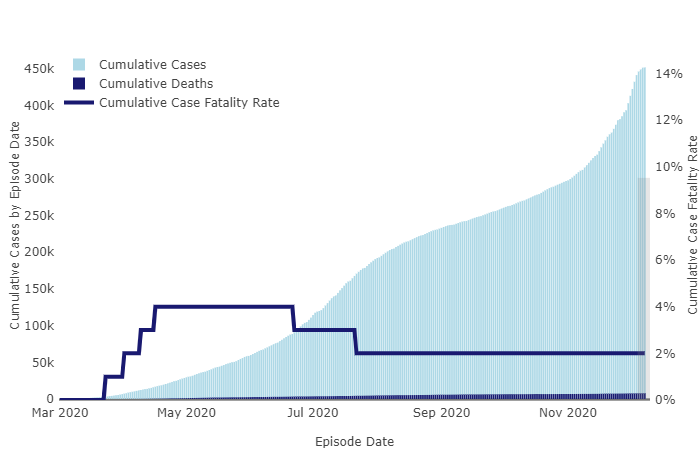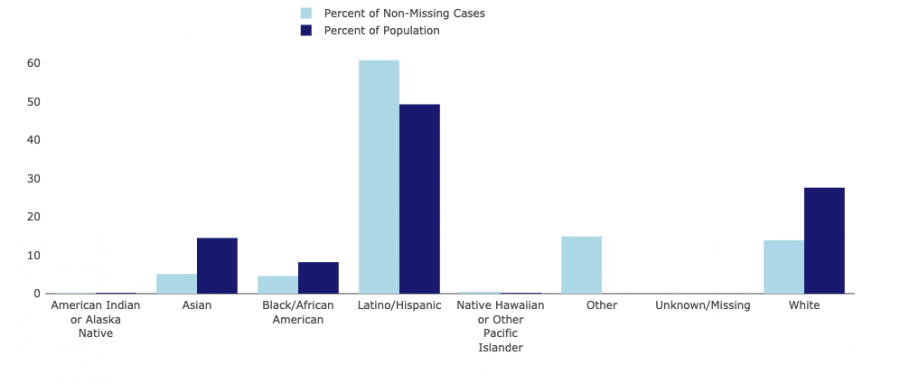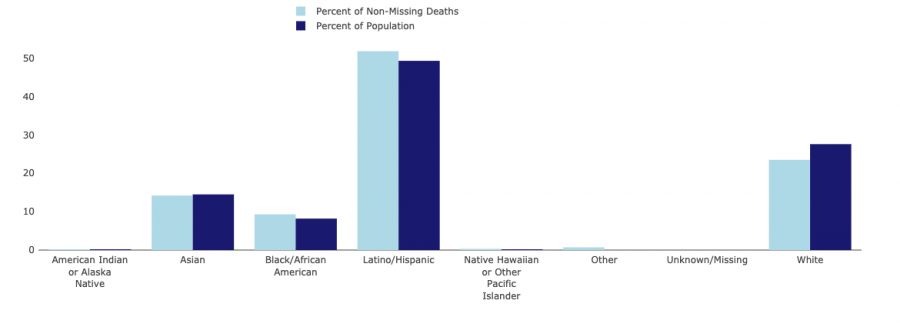ICU beds reach 94% capacity in Southern California
December 11, 2020
Los Angeles County has the highest number of cumulative cases in the United States, while multiple other counties in California see a rise in the number of cases per capita.
The Centers for Disease Control and Prevention forecasts an upward trend in the number of deaths nationwide. L.A. County currently holds the record for the most confirmed cases in the nation.
We have compiled data and guidance from the Los Angeles County Department of Public Health to provide an update for L.A. County. Data is up to date as of Dec. 11. Here is your weekly COVID-19 update.
Local official updates:
Southern California enters Stay at Home Order
ICU capacity in Southern California fell under 15% on Dec. 4, triggering the stay-at-home order outlined by Gov. Gavin Newsom. The San Joaquin Valley region also fell under the state’s order.
The order went into effect on Sunday and affects over 33 million Californians in both regions.
Gatherings between multiple households are prohibited under the order. Bars, wineries, indoor recreation, cardrooms and personal services are temporarily closed until Dec. 28.
The order had originally called for outdoor playgrounds to close, but state officials reversed the order after facing pushback from parents.
Schools already open for in-person learning are allowed to stay open. Retail remains open at 20% capacity.
The temporary stay-at-home order will be lifted on Dec. 28 if ICU availability projections for the following month are at or above 15%.
As of Friday, ICU capacity in the Southern California region is 6.2%.
Los Angeles Unified School District campuses closed
LAUSD Superintendent Austin Beutner announced on Monday that LAUSD campuses will be closed starting Thursday.
The closures affect about 4,000 students in kindergarten through 12th grade.
All in-person learning is suspended as of Monday. Grab & Go Food Centers at LAUSD schools will remain operational.
“Because of the dangerously high level of COVID-19 in the Los Angeles area, it is no longer safe and appropriate to have any students on campus,” Beutner said. “We will also be asking those who are currently working at schools to work from home if at all possible for the rest of the semester.”
The campus closures will remain in effect until the new semester, which begins on Jan. 11.
Cases, hospitalizations and deaths surging in Los Angeles County
The L.A. County Department of Public Health Director Barbara Ferrer shared multiple graphs on Wednesday that reflect surges in cases, hospitalizations and deaths in the county.
The 7-day average of daily cases, which is the number of active cases, has increased 300% between Nov. 1 and Nov. 30.
The 3-day average positivity rate, which is the rate at which tests come back positive, has increased 142% between the beginning of November and Nov. 29. The cumulative positivity rate is 11%, Ferrer said.
Hospitalizations have tripled in the month of November.
Since Nov. 9, the average daily deaths increased sharply by 258%.
Ferrer became tearful as she described the number of deaths in the County.
“While this trendline provides a frightening visual of our reality, the more terrible truth is that over 8,000 people who were beloved members of their families are not coming back,” Ferrer said. “And their deaths are an incalculable loss to their friends and their family, as well as our community.”
Food and Drug Administration advisory panel recommends approval of COVID-19 vaccine
The FDA Vaccines and Related Biological Products Advisory Committee advisory panel recommended the approval of the Pfizer and BioNTech vaccine on Thursday, concluding that the vaccine is safe for people over the age of 16.
The FDA is likely to follow the advisory group’s recommendation. Once the FDA makes its final decision, millions of vaccines will begin to make their way across the United States.
The FDA could grant emergency use authorization in the coming days.
Total cases:

Since the first confirmed case of COVID-19 in L.A. County on Jan. 26, the number of positive cases continues to rise. Over 4.5% of L.A. County’s population of 10 million has had COVID-19.

CSUN cases:
As of Dec. 7, there have been 48 reported cases among students and 33 reported cases among employees.
There are two reported cases among non-employee contractors.
There are no current cases that have been reported as a result of on-campus exposure.
[insert chart of CSUN cases]
These cases are reported to CSUN by individuals or public health officials. The university does not disclose the specific location of infected individuals for privacy reasons, but potentially exposed areas are disinfected prior to reopening.
If you test positive for COVID-19, whether or not you have been on campus, notify Yolanda Chassiakos, the CSUN Pandemic Manager, by emailing linda.reid.chassiakos@csun.edu.
Hospitalizations:
There are 3,850 COVID-19 positive patients currently hospitalized in L.A. County. There are 856 COVID-19 positive patients in the Intensive Care Unit. The County currently has 440 available ICU beds.
Race and ethnicity:


L.A. County’s data shows cases and deaths disproportionately affect people of color.
The L.A. County Department of Public Health reported that Latinos make up 60.8% of cases with data on race and ethnicity compared to the population, while whites account for 13.9% of cases compared to the population.
Latinos account for 51.8% of all COVID-19 deaths when compared to the population.
What’s open:
Grocery stores – limited to 35% capacity
Essential retail – limited to 20% capacity
Some non-essential retail with modifications
Parks and beaches with modifications
Golf courses
Hotels with modifications
Shared residential pools
Gyms – outdoors with modifications
Indoor shopping malls – limited to 20% capacity
Wineries/breweries – indoor retail only with a limit of 20% capacity
What’s closed:
Indoor dining at restaurants
Indoor houses of worship
Indoor gyms
Hair salons
Barber shops
Nail salons
Bars
Cardrooms
Zoos/Aquariums
Tattoo shops
Face masks are still required in public. Gatherings should be limited to only people in your household.
Testing:
The L.A. County website has a list of testing locations available for both walk-up and drive-up testing. Testing is available by appointment only.
A comprehensive map of testing locations can be found here. Hours of operation at city testing locations have been extended from 8 a.m. to 4 p.m. daily.